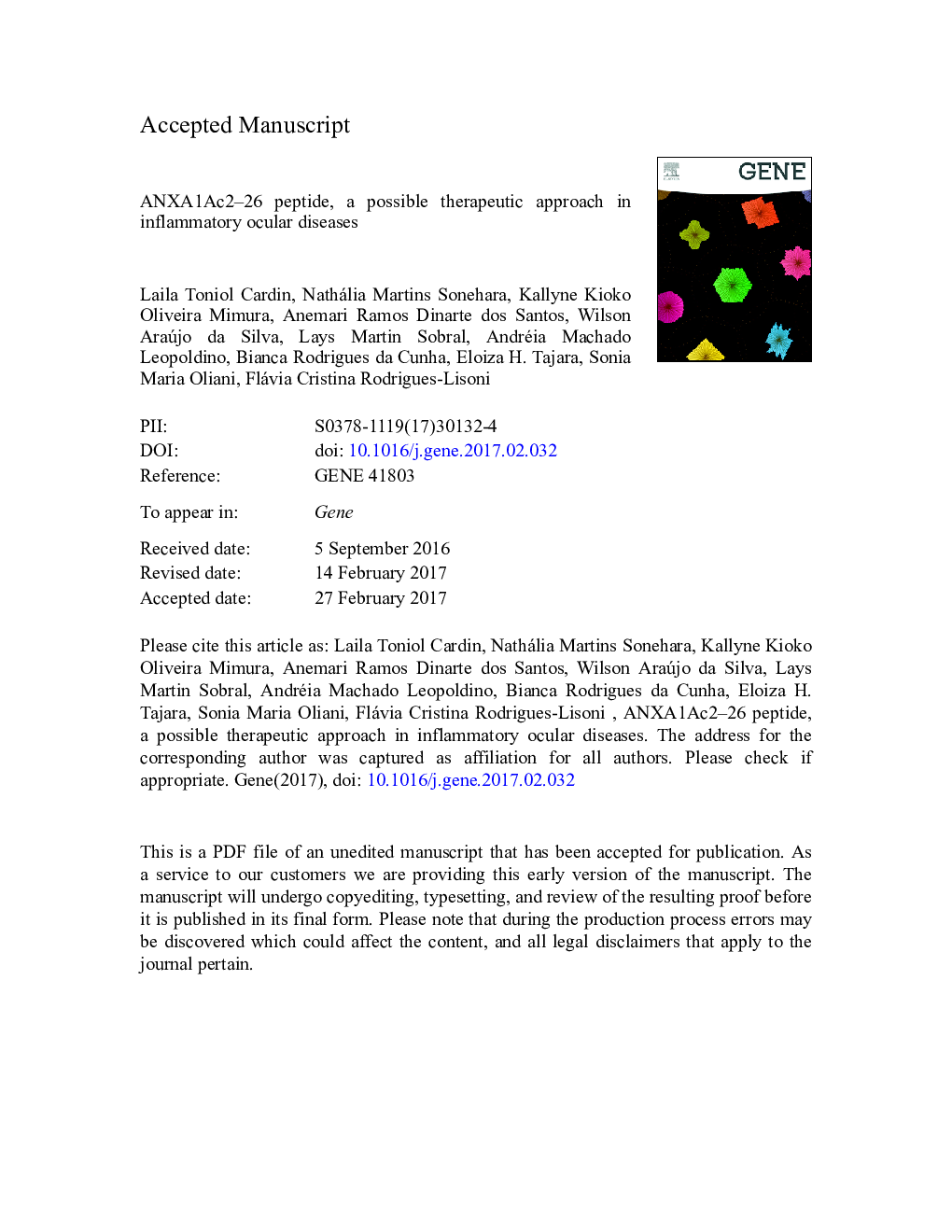| کد مقاله | کد نشریه | سال انتشار | مقاله انگلیسی | نسخه تمام متن |
|---|---|---|---|---|
| 5589830 | 1569822 | 2017 | 27 صفحه PDF | دانلود رایگان |
عنوان انگلیسی مقاله ISI
ANXA1Ac2-26 peptide, a possible therapeutic approach in inflammatory ocular diseases
دانلود مقاله + سفارش ترجمه
دانلود مقاله ISI انگلیسی
رایگان برای ایرانیان
کلمات کلیدی
RLRsECLRPEANXMAP1BPLA2Smad2ARPE-19ALDH1A3Rapid Subtraction HybridizationBRBLRATNLRsDulbecco minimum essential mediumUBCFactor Nuclear kappa Bhypoxia inducible factor 1, alpha subunitMboIubiquitin CSETD7LPSDMEMFBSCTGFIgGHClMgCl2MYCDTTGAPDHAnxa1HRPNF-kBHIF1a - HIF1MAPK - MAPKTLRs - TLR هاphospholipase A2 - آنزیم فسفولیپاز A2 Annexin - آنکسینAnnexin A1 - آنیلیون A1hydrochloric acid - اسید هیدروکلریک یا اسید کلریدریک یا جوهر نمک retinal pigment epithelium - اپیتلیوم رنگدانه شبکیهimmunoglobulin - ایمونوگلوبولینinterleukin - اینترلوکینbeta-actin - بتا آکتینrash - راشfetal bovine serum - سرم جنین گاوActb - عملConnective tissue growth factor - فاکتور رشد بافت همبندElectrochemical luminescence - لومینسانس الکتروشیمیاییblood retinal barrier - مانع خون شبکیهHorseradish peroxidase - پراکسیداز هوررادیشMicrotubule-associated protein 1B - پروتئین وابسته به میکروتوبول 1Bmitogen-activated protein kinase - پروتئین کیناز فعال با mitogenMagnesium chloride - کلرید منیزیمglyceraldehyde 3-phosphate dehydrogenase - گلیسرولیدید 3-فسفات دهیدروژنازToll-like receptors - گیرنده های پولی مانندRIG-I-like receptors - گیرنده هایی مانند RIG-I
موضوعات مرتبط
علوم زیستی و بیوفناوری
بیوشیمی، ژنتیک و زیست شناسی مولکولی
ژنتیک
پیش نمایش صفحه اول مقاله

چکیده انگلیسی
The eye is immunologically privileged when inflammatory responses are suppressed. One component responsible for the suppression of inflammatory responses is the blood retinal barrier, which comprises the retinal pigment epithelium. The destruction of this barrier initiates inflammation, which can affect any part of the eye. Therefore, inflammatory response is controlled by the action of anti-inflammatory mediators, among these mediators, annexin A1 (ANXA1) protein acts as a modulator of inflammation. In this study we aimed to improve the knowledge of this area by investigating how a peptide of the ANXA1 protein (ANXA1Ac2-26) modulates the morphology, proliferation, migration and expression of genes and proteins in human retinal pigment epithelium cells (ARPE-19). Determining how signaling pathways (NF-κB and UBC) are modulated by the ANXA1Ac2-26 peptide could be important for understanding the inflammatory process. ARPE-19 cells were activated by bacterial lipopolysaccharide endotoxin (LPS) and treated with ANXA1Ac2-26 peptide, in a concentration of 1.7 μM and 33.8 μM. We observed that the LPS activation diminished the levels of endogenous ANXA1 after 2 h and 24 h and ANXA1Ac2-26 peptide decreased the proliferation and re-establishes the migration of ARPE-19 cells. After using a hybridization approach, 80 differentially expressed genes were found. Five of these genes were selected (LRAT, CTGF, MAP1B, ALDH1A3 and SETD7) and all were down-regulated after treatment with the peptide. The genes CTGF and LRAT would be considered as potential molecular markers of ophthalmologic inflammation. The expression of pro-inflammatory cytokines was also decreased after the treatment, indicating the efficiency of the anti-inflammatory peptide at high concentrations, since the reduction in the levels of these mediators were observed after the treatment with ANXA1Ac2-26 peptide at 33.8 μM. Our results suggest that the retinal pigment epithelial cells are a potential target of the ANXA1 protein and point to possible applications of the ANXA1Ac2-26 peptide as an innovative therapy for the treatment of ocular inflammation.
ناشر
Database: Elsevier - ScienceDirect (ساینس دایرکت)
Journal: Gene - Volume 614, 30 May 2017, Pages 26-36
Journal: Gene - Volume 614, 30 May 2017, Pages 26-36
نویسندگان
Laila Toniol Cardin, Nathália Martins Sonehara, Kallyne Kioko Oliveira Mimura, Anemari Ramos Dinarte dos Santos, Wilson Araújo Junior, Lays Martin Sobral, Andréia Machado Leopoldino, Bianca Rodrigues da Cunha, Eloiza H. Tajara, Sonia Maria Oliani,